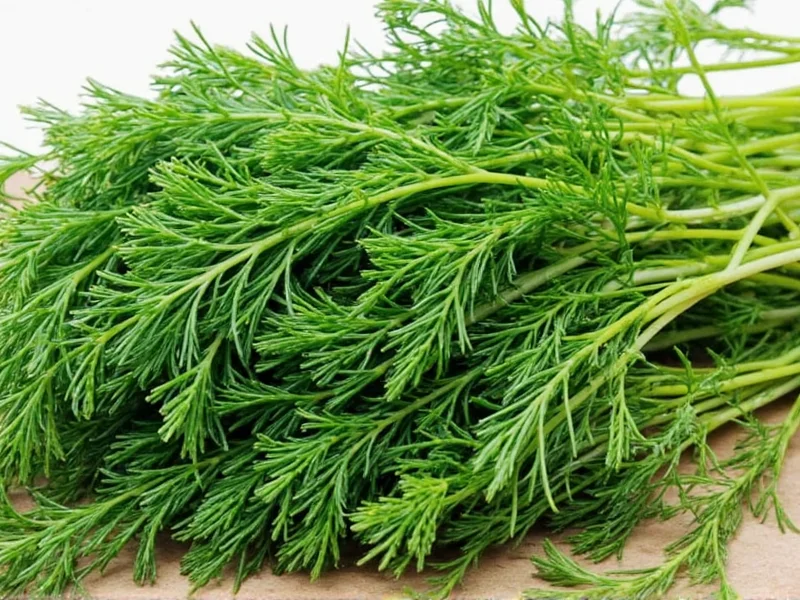When you're mid-recipe and realize you're out of fresh dill sprigs, knowing reliable substitutes prevents meal disruption. Dill's distinctive flavor—slightly sweet with grassy, anise-like notes—plays a crucial role in many dishes, particularly Scandinavian, Eastern European, and Mediterranean cuisines. Understanding proper substitution ratios and flavor profiles ensures your culinary creations maintain their intended character without compromising quality.
Understanding Dill Sprigs and Their Culinary Role
Dill sprigs refer to the feathery fronds of the dill plant (Anethum graveolens), typically sold in bunches at grocery stores. Each sprig measures approximately 2-3 inches long and contributes both visual appeal and aromatic complexity to dishes. Unlike dill seed (which has a stronger, sharper flavor) or dried dill weed (more concentrated but less vibrant), fresh sprigs offer a delicate balance essential for finishing dishes like gravlax, borscht, or cucumber salads.
Top Substitutes for Dill Sprigs by Application
Not all dill alternatives work equally well across recipes. Your substitution choice should align with both the dish type and whether you need the herb for garnish, flavor base, or preservation purposes. Here's how to select the optimal replacement:
| Substitute | Ratio vs. 1 Fresh Sprig | Best For | Flavor Notes |
|---|---|---|---|
| Dried dill weed | 1/4-1/2 tsp | Pickling, soups, stews | More intense, less bright; add early in cooking |
| Fresh tarragon | 1 tsp | Fish, creamy sauces, salads | Slightly sweeter with anise notes; excellent dill sprig substitute for tzatziki |
| Fennel fronds | 1 tsp | Seafood, roasted vegetables | Milder licorice flavor; ideal substitute for dill sprigs in salmon recipes |
| Parsley + lemon zest | 1 tsp + 1/4 tsp | Garnishes, cold dishes | Provides freshness without dill's distinct profile |
| Dill seed | 1/8 tsp | Pickling, breads, hearty stews | Stronger, earthier; use sparingly as dill sprig replacement |
Recipe-Specific Substitution Guidance
Successful herb substitution requires considering both flavor chemistry and textural elements. Here's how to approach common culinary scenarios:
For Fish and Seafood Dishes
When preparing gravlax, baked salmon, or shrimp cocktails, fresh alternatives work best. Fennel fronds provide the closest visual and flavor match for dill sprigs in salmon recipes, offering similar feathery texture with complementary anise notes. Tarragon makes an excellent second choice, particularly in creamy seafood sauces where its slight sweetness enhances delicate fish flavors. Avoid dill seed here—it overwhelms subtle seafood profiles.
For Pickling and Preserving
Pickling requires robust flavor that withstands vinegar and time. Dried dill weed serves as the most reliable dill sprig substitute for pickling, using a 1:3 conversion ratio (1 tablespoon fresh = 1 teaspoon dried). For refrigerator pickles, add dried dill at the beginning of the process to allow full flavor extraction. When making traditional fermented pickles, consider adding a small dill seed for complexity while relying primarily on dried weed for authentic dill flavor.
For Cold Dishes and Garnishes
Cucumber salads, tzatziki, and cold borscht rely on dill's bright freshness. For tzatziki specifically, tarragon instead of dill creates a sophisticated flavor variation while maintaining the necessary herbal quality. If using parsley as a dill substitute, always include lemon zest to approximate dill's citrus undertones. Remember that dried herbs work poorly here—opt for fresh alternatives when possible for proper texture and immediate flavor release.
Common Substitution Mistakes to Avoid
Many home cooks make critical errors when replacing dill sprigs that compromise dish quality. The most frequent mistake involves improper measurement conversion—using equal volumes of dried versus fresh herbs. Dried dill is significantly more concentrated, requiring only one-third the amount of fresh. Another common error is substituting cilantro, which has a completely different flavor profile that clashes with traditional dill applications. Basil also fails as a substitute due to its sweet, peppery notes that overwhelm dill's delicate character.
Preserving Fresh Dill for Future Use
To avoid future substitution needs, properly store fresh dill by trimming stem ends and placing in a glass with 1 inch of water, covering loosely with a plastic bag in the refrigerator. This method keeps dill sprigs vibrant for 7-10 days. For longer storage, freeze dill sprigs in ice cube trays with water or olive oil—frozen dill works well in cooked dishes though loses garnish quality. When converting frozen dill to dried, use a 2:1 ratio (2 parts frozen = 1 part dried) for accurate flavor balance.











 浙公网安备
33010002000092号
浙公网安备
33010002000092号 浙B2-20120091-4
浙B2-20120091-4